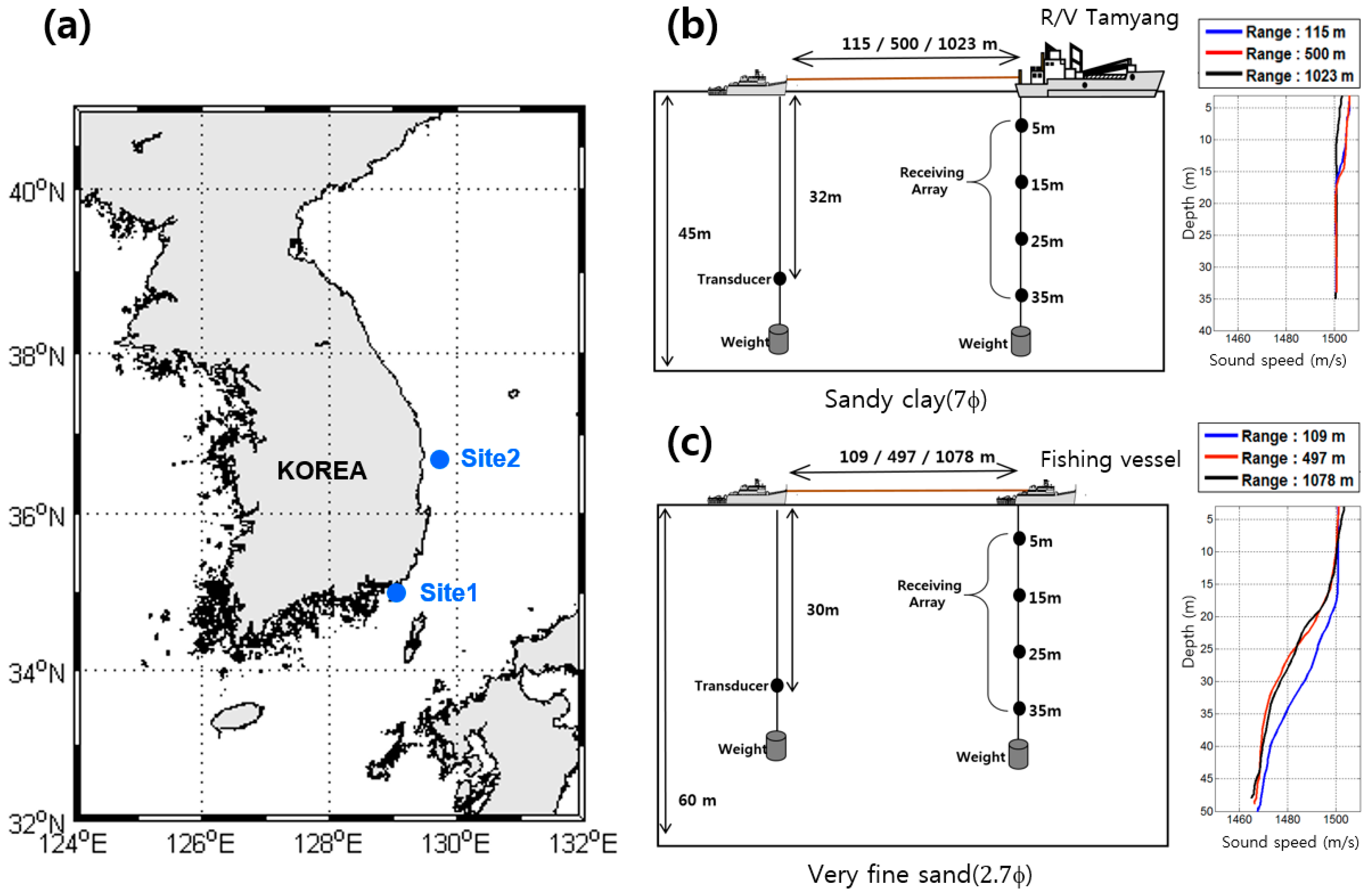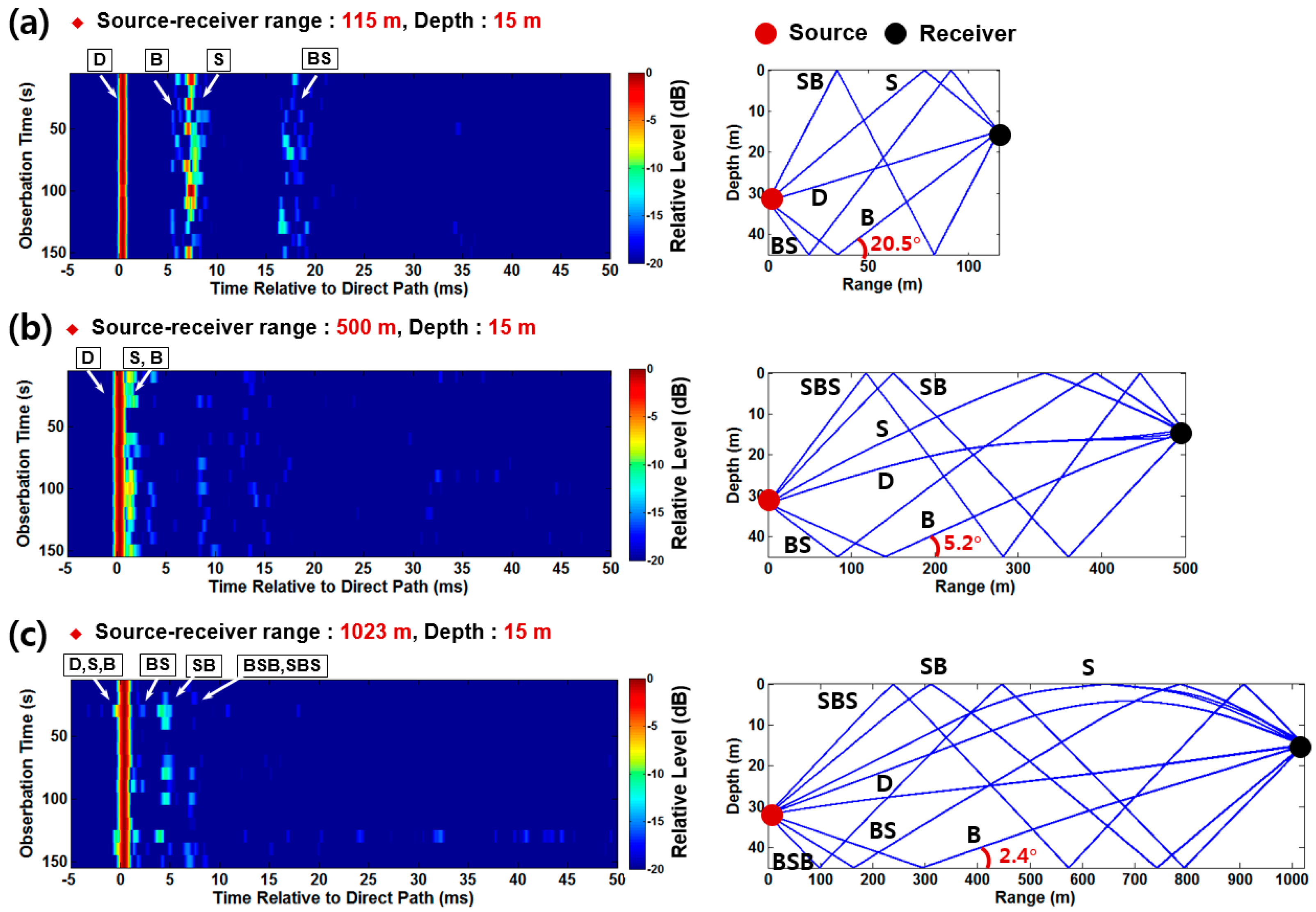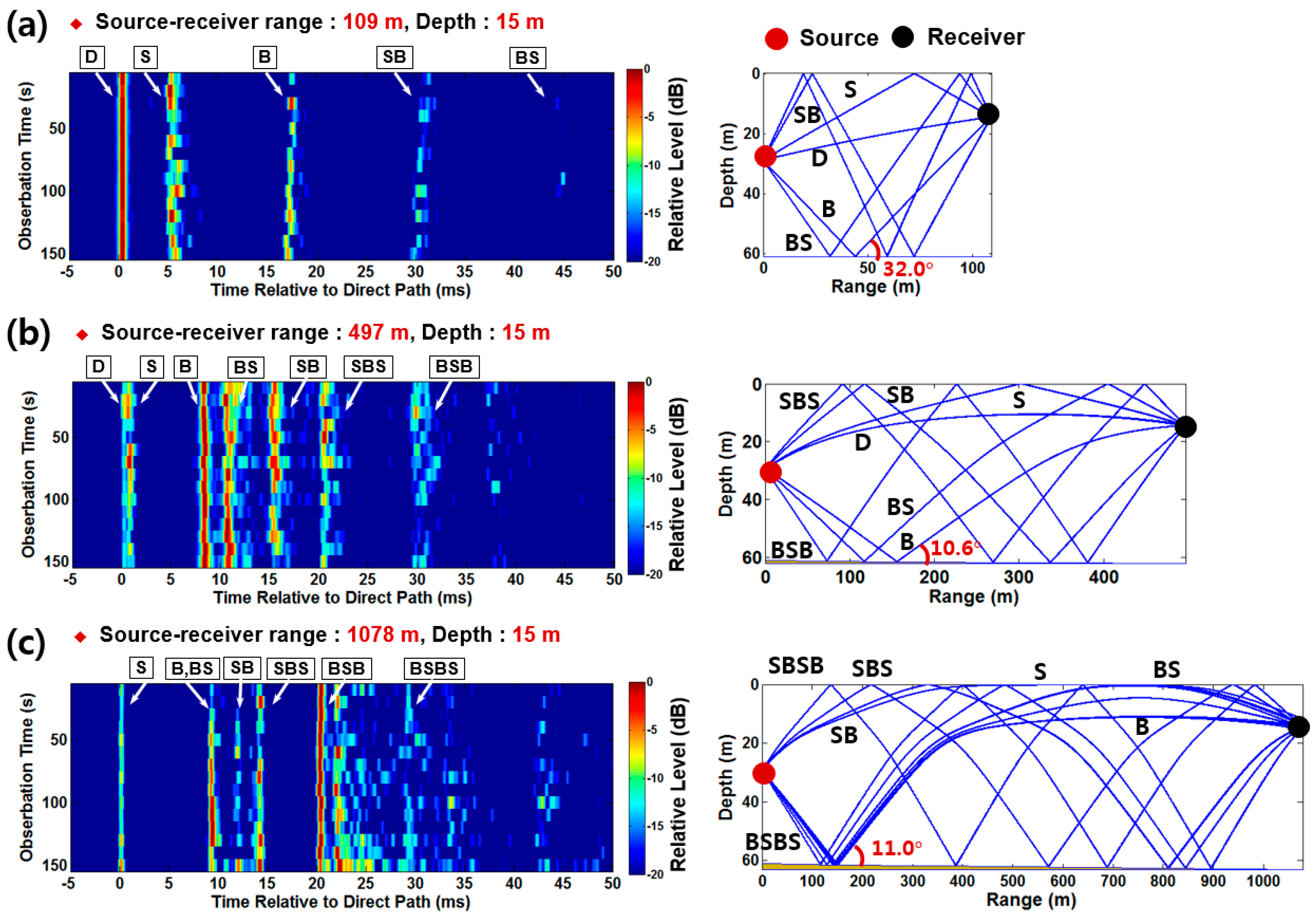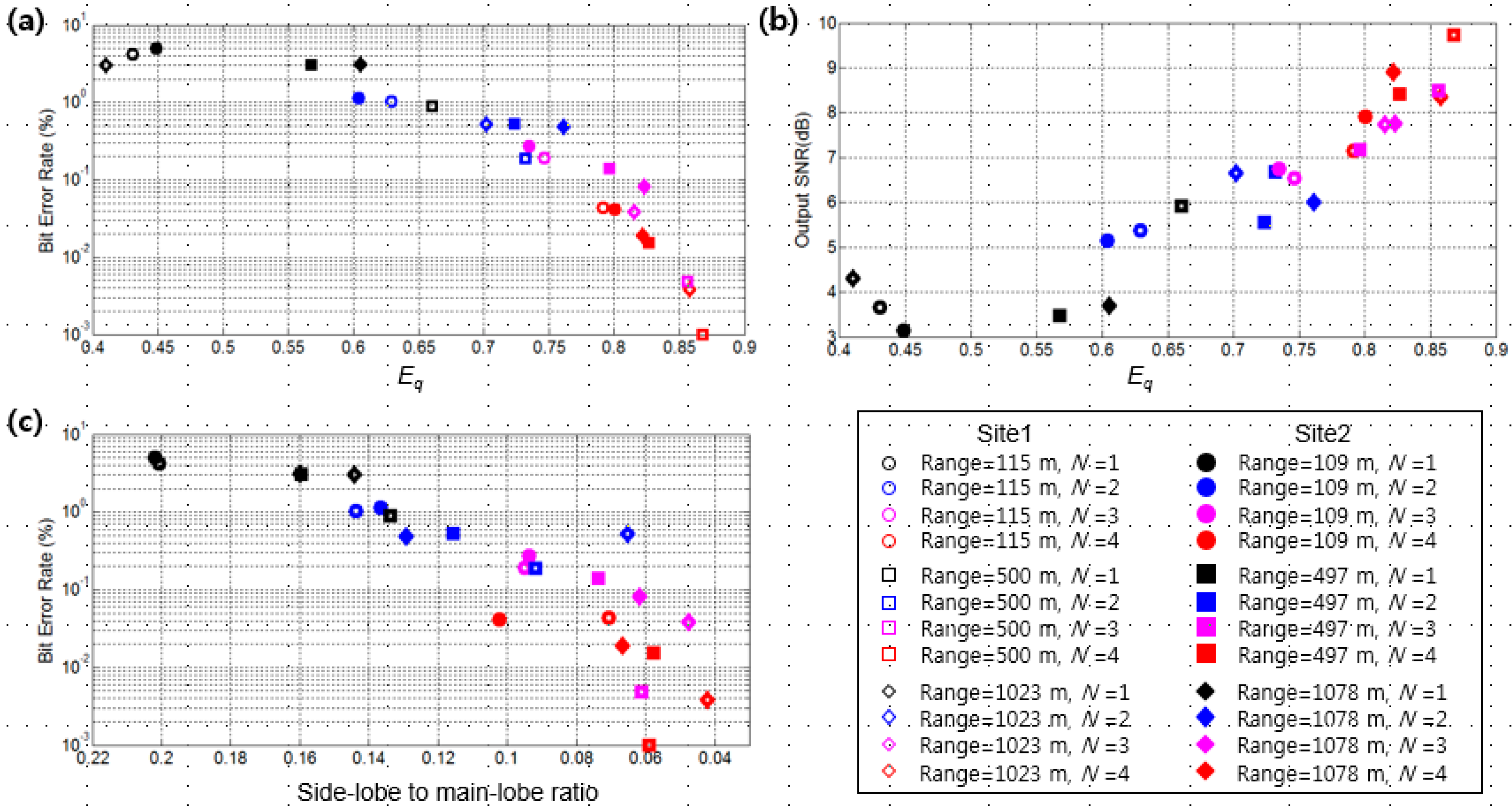Estimate of Passive Time Reversal Communication Performance in Shallow Water
Abstract
:1. Introduction
2. Parameter
3. Experiment and Site
4. Results
4.1. Channel Characteristics at the Experimental Sites
4.2. Performance Analysis of Passive Time Reversal Communication
5. Summary and Discussion
- Quick assessment of symbol rate of time reversal communication system
- Determination of receiver array dimension required to meet the BER requirement, including the optimal number of channel elements and their spacing
- Decision of need for additional equalization
Acknowledgments
Author Contributions
Conflicts of Interest
References
- Yang, T.C. Properties of underwater acoustic communication channels in shallow water. J. Acoust. Soc. Am. 2012, 131, 129–145. [Google Scholar] [CrossRef] [PubMed]
- Kilfoyle, D.B.; Baggeroer, A.B. The State of the Art in Underwater Acoustic Telemetry. IEEE J. Ocean. Eng. 2000, 25, 4–27. [Google Scholar] [CrossRef]
- Rouseff, D.; Badiey, M.; Song, A. Effect of reflected and refracted signals on coherent underwater acoustic communication: Results from the Kauai experiment (KauaiEx 2003). J. Acoust. Soc. Am. 2009, 126, 2359–2366. [Google Scholar] [CrossRef] [PubMed]
- Song, A.; Badiey, M.; Song, H.C.; Hodgkiss, S.; Porter, M.B. Impact of ocean variability on coherent underwater acoustic communications during the Kauai experiment (KauaiEx). J. Acoust. Soc. Am. 2008, 123, 856–865. [Google Scholar] [CrossRef] [PubMed]
- Stojanovic, M.; Catipovic, J.A.; Proakis, J.G. Adaptive multichannel combining and equalization for underwater acoustic communication. J. Acoust. Soc. Am. 1993, 94, 1621–1631. [Google Scholar] [CrossRef]
- Siderius, M.; Porter, M.B.; Hursky, P.; McDonald, V. Effects of ocean thermocline variability on noncoherent underwater acoustic communications. J. Acoust. Soc. Am. 2007, 121, 1895–1908. [Google Scholar] [CrossRef] [PubMed]
- Walree, P.A. Propagation and Scattering Effects in Underwater Acoustic Communication Channels. IEEE J. Ocean. Eng. 2013, 38, 614–631. [Google Scholar] [CrossRef]
- Badiey, M.; Mu, Y.; Simmen, J.A.; Forsythe, S.E. Signal Variability in Shallow-Water Sound Channels. IEEE J. Ocean. Eng. 2000, 25, 492–500. [Google Scholar] [CrossRef]
- Yang, T.C. Measurements of temporal coherence of sound transmissions through shallow water. J. Acoust. Soc. Am. 2006, 120, 2595–2614. [Google Scholar] [CrossRef]
- Hirsch, D.; Wolf, B. A simple adaptive equalizer for efficient data transmission. IEEE J. Trans. Commun. 1970, 18, 5–12. [Google Scholar] [CrossRef]
- Proakis, J.G.; Miller, J.H. An adaptive receiver for digital signaling though channel with intersymbol interference. IEEE J. Trans. Inf. Theory 1969, 15, 484–497. [Google Scholar] [CrossRef]
- Proakis, J.G. Digital Communications; McGraw-Hill: New York, NY, USA, 1989; pp. 680–693. [Google Scholar]
- Balaban, P.; Salz, J. Optimum diversity combining and equalization in digital data transmission with applications to cellular mobile radio. IEEE J. Trans. Commun. 1992, 40, 885–895. [Google Scholar] [CrossRef]
- Rouseff, D.; Jackson, D.R.; Fox, W.L.J.; Jones, C.D.; Ritcey, J.A.; Dowling, D.R. Underwater Acoustic Communication by Passive-Phase Conjugation: Theory and Experimental Results. IEEE J. Ocean. Eng. 2001, 26, 821–831. [Google Scholar] [CrossRef]
- Edelmann, G.F.; Akal, T.; Hodgkiss, W.S.; Kim, S.; Kuperman, W.A.; Song, H.C. An Initial Demonstration of Underwater Acoustic Communication Using Time Reversal. IEEE J. Ocean. Eng. 2002, 27, 602–609. [Google Scholar] [CrossRef]
- Edelmann, G.F.; Song, H.C.; Kim, S.; Hodgkiss, W.S.; Kuperman, W.A.; Akal, T. Underwater Acoustic Communications Using Time Reversal. IEEE J. Ocean. Eng. 2005, 30, 852–864. [Google Scholar] [CrossRef]
- Song, H.C.; Hodgkiss, W.S.; Kuperman, W.A.; Stevenson, M.; Akal, T. Improvement of Time-Reversal Communications Using Adaptive Channel Equalizers. IEEE J. Ocean. Eng. 2006, 31, 487–496. [Google Scholar] [CrossRef]
- Yang, T.C. Temporal Resolutions of Time-Reversal and Passive-Phase Conjugation for Underwater Acoustic Communications. IEEE J. Ocean. Eng. 2003, 28, 229–245. [Google Scholar] [CrossRef]
- Song, H.C.; Hodgkiss, W.S.; Kuperman, W.A.; Higley, W.J.; Raghukumar, K.; Akal, T. Spatial diversity in passive time reversal communications. J. Acoust. Soc. Am. 2006, 120, 2067–2076. [Google Scholar] [CrossRef]
- Song, H.C.; Kuperman, W.A.; Hodgkiss, W.S. Basin-scale time reversal communications. J. Acoust. Soc. Am. 2009, 125, 212–217. [Google Scholar] [CrossRef] [PubMed]
- Song, H.C. Time reversal communication in a time-varying sparse channel. J. Acoust. Soc. Am. 2011, 130, EL161–EL166. [Google Scholar] [CrossRef] [PubMed]
- Dahl, P.H.; Choi, J.W. The East China Sea as an Underwater Acoustic Communication Channel: Measurements of the Channel Impulse Response (U). U. S. Navy J. Underw. Acoust. 2006, 56, 1–12. [Google Scholar]
- Son, S.U.; Kim, H.; Joo, J.; Choi, J.W. Multipath Effects on High-Frequency Coherent Acoustic Communications in Shallow Water. Jpn. J. Appl. Phys. 2013, 52, 07HG03. [Google Scholar] [CrossRef]
- Jackson, D.R.; Richardson, M.D. High-Frequency Seafloor Acoustics; Springer: New York, NY, USA, 2006; pp. 313–314. [Google Scholar]
- Porter, M.B.; Bucker, H.P. Gaussian beam tracing for computing ocean acoustic fields. J. Acoust. Soc. Am. 1987, 82, 1349–1359. [Google Scholar] [CrossRef]
- Stojanovic, M.; Catipovic, J.A.; Proakis, J.G. Phase-Coherent Digital Communications for Underwater Acoustic Channels. IEEE J. Ocean. Eng. 1994, 19, 100–111. [Google Scholar] [CrossRef]






© 2017 by the authors. Licensee MDPI, Basel, Switzerland. This article is an open access article distributed under the terms and conditions of the Creative Commons Attribution (CC BY) license (http://creativecommons.org/licenses/by/4.0/).
Share and Cite
Kim, S.; Son, S.-U.; Kim, H.; Choi, K.-H.; Choi, J.W. Estimate of Passive Time Reversal Communication Performance in Shallow Water. Appl. Sci. 2018, 8, 23. https://doi.org/10.3390/app8010023
Kim S, Son S-U, Kim H, Choi K-H, Choi JW. Estimate of Passive Time Reversal Communication Performance in Shallow Water. Applied Sciences. 2018; 8(1):23. https://doi.org/10.3390/app8010023
Chicago/Turabian StyleKim, Sunhyo, Su-Uk Son, Hyeonsu Kim, Kang-Hoon Choi, and Jee Woong Choi. 2018. "Estimate of Passive Time Reversal Communication Performance in Shallow Water" Applied Sciences 8, no. 1: 23. https://doi.org/10.3390/app8010023




